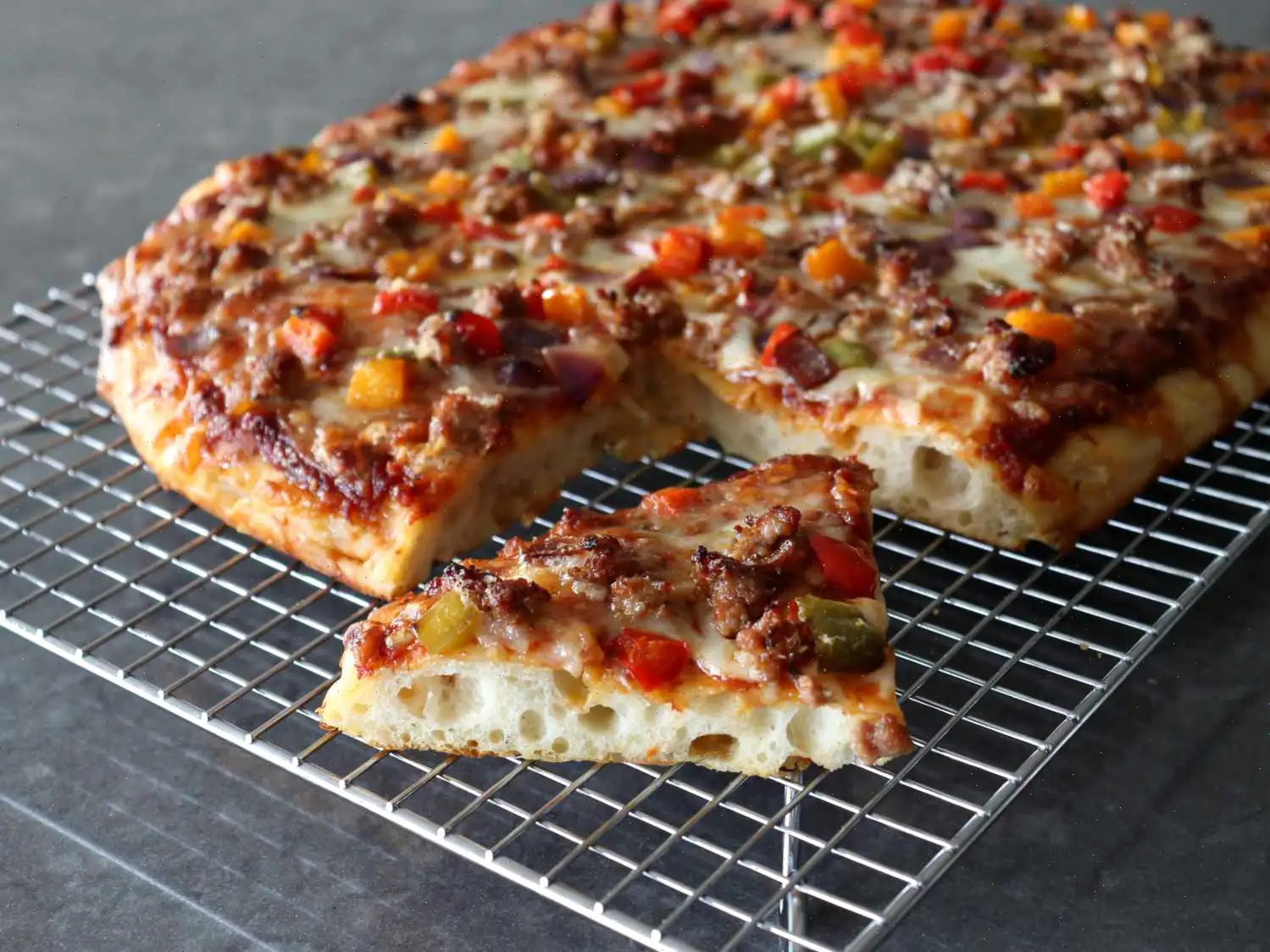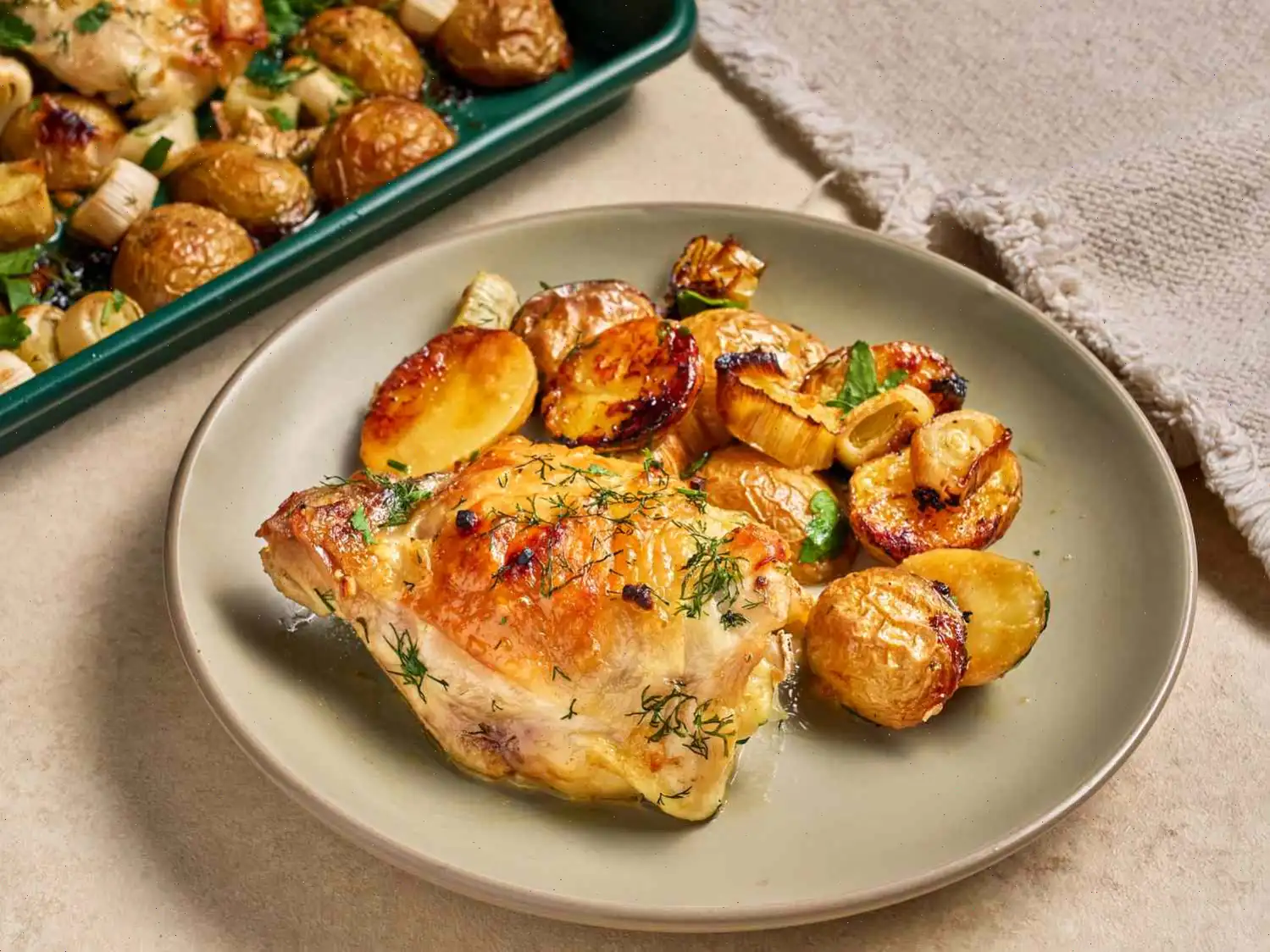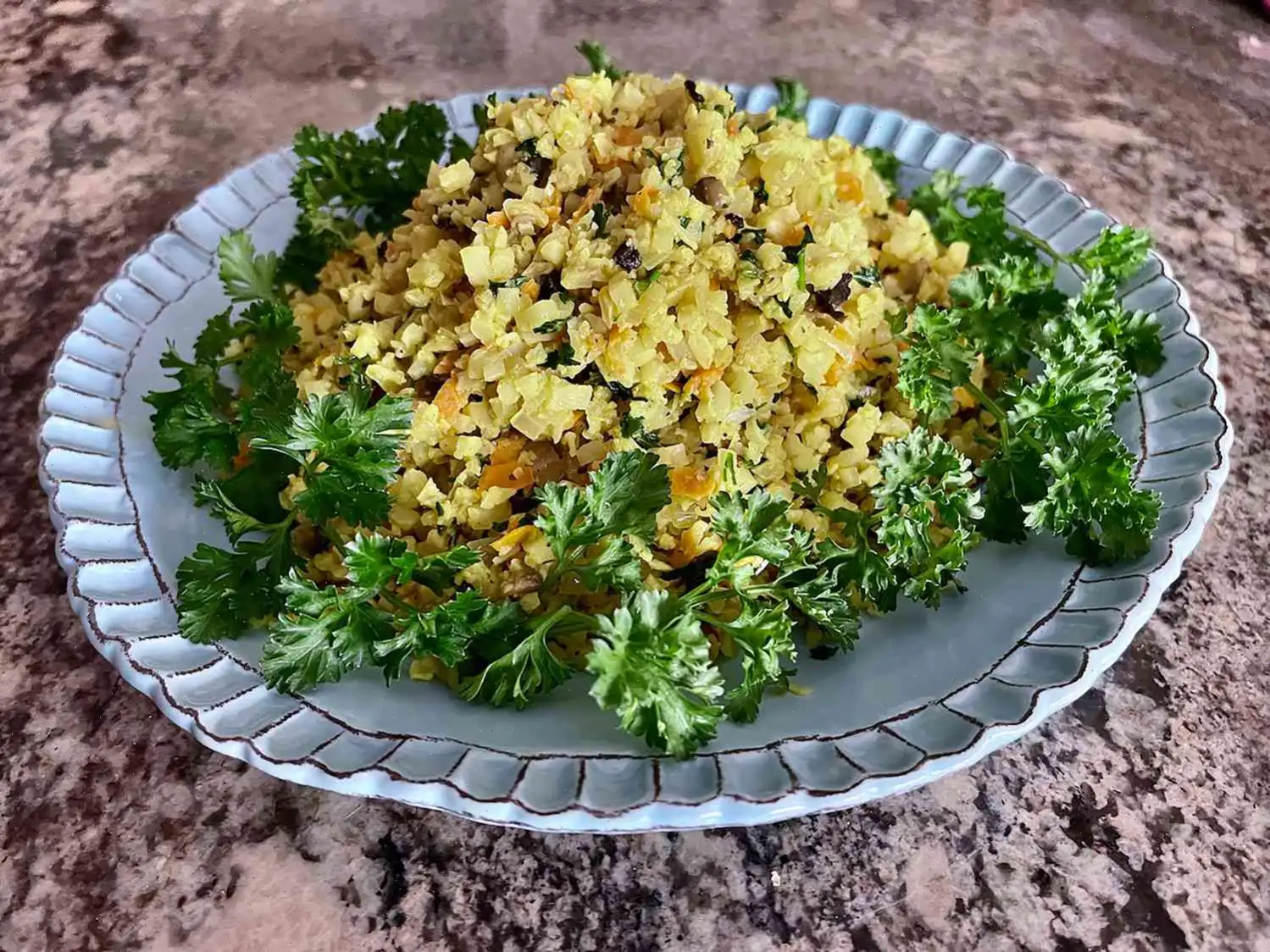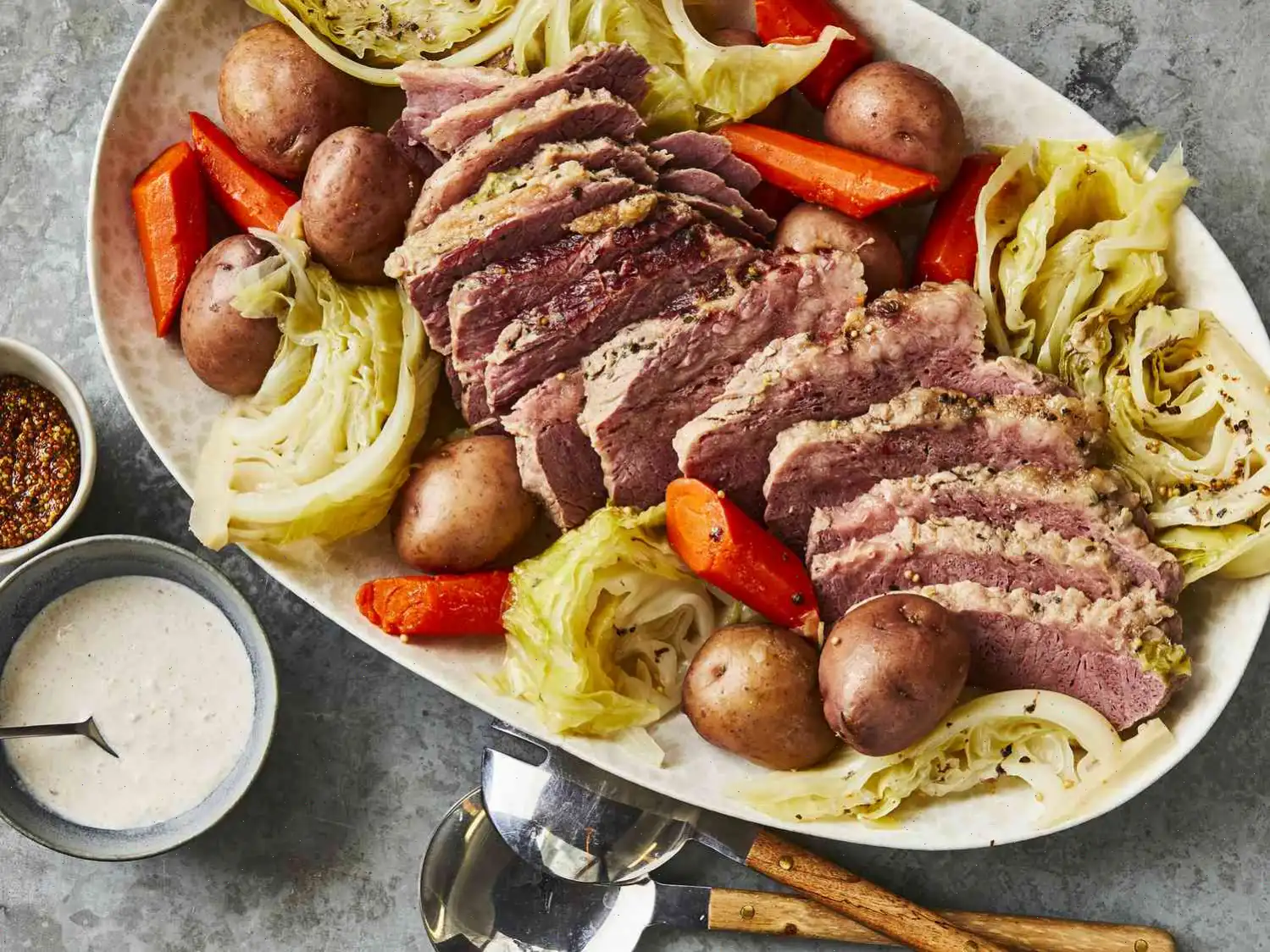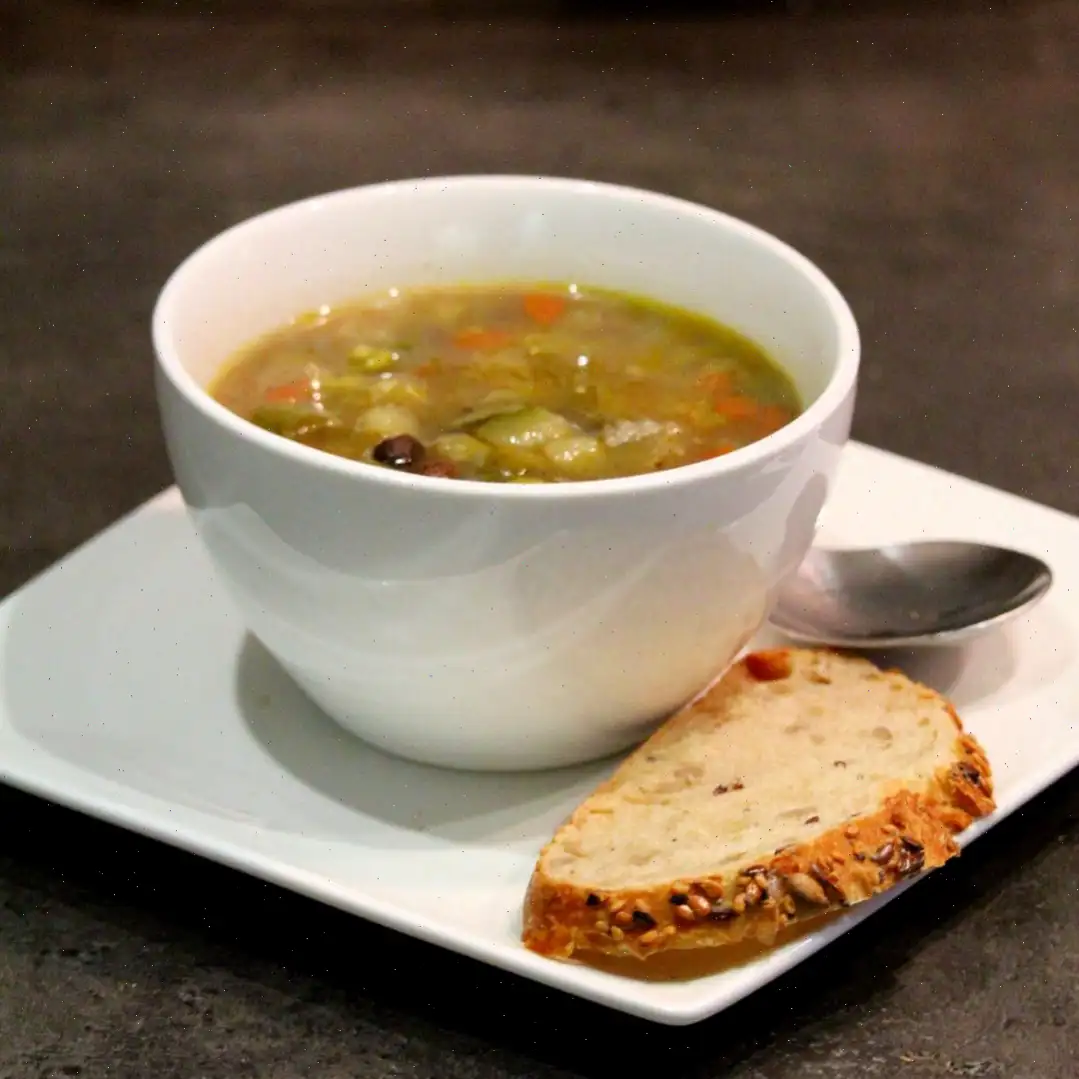
Roman-Style Pizza Recipe
Ingredients:
- Dough:
- 4 1/4 cups bread flour (500 grams)
- 1 rounded teaspoon dry yeast (3.5 grams)
- 1 1/2 cups plus 3 tablespoons water (400 ml)
- Generous 1 1/2 tablespoons olive oil (20 ml), plus 2 teaspoons more to oil
- Rounded 1 1/2 teaspoons sea salt or kosher salt (10 grams)
- Pizza:
- 6 ounces Italian sausage
- 1 cup diced sweet peppers and onions
- 1 1/2 cups prepared pizza sauce
- 2 cups shredded mozzarella cheese
- 1 1/2 cups shredded Monterey Jack cheese
- 1/2 cup freshly grated Parmigiano Reggiano cheese
- 1/4 cup olive oil, divided
Directions:
- In a large bowl, combine flour, yeast, and water. Stir with a wooden spoon until most of the flour has incorporated and a rough dough forms.
- Add salt and olive oil, and continue mixing with the spoon for about 3 minutes, until a smooth, soft, and sticky dough forms. Clean off the spoon and scrape down the sides of the bowl.
- Cover the bowl and let the dough rest for 15 minutes.
- Perform the first set of rotating folds: With damp hands, reach under the dough in the bowl, pull it up, and stretch it over the top. Rotate the bowl a few inches and repeat 10 to 12 times. Shape the dough into a ball with the smoothest side facing up. Cover and let rest for another 15 minutes.
- Repeat the stretch, fold, and rest process two more times. After the third fold, transfer the dough to an oiled , rubbing a few drops of olive oil on the dough. Cover and refrigerate for 24 hours or until doubled in size.
- After 24 hours, remove the dough from the refrigerator and let it sit at room temperature for 1 hour.
- Meanwhile, prepare the toppings: In a skillet over medium heat, cook and stir the sausage for about 10 minutes, breaking it apart into small pieces until browned and crumbly. Remove from the pan and set aside to cool.
- In the same skillet, add the diced sweet peppers and onions, and cook for 3 to 5 minutes, until they begin to soften. Remove and set aside.
- Preheat the oven to 500F (250C). Generously oil a sheet pan with olive oil, or line with parchment paper to prevent sticking.
- Transfer the dough to the prepared pan. Using oiled fingers, press the dough into a rectangle that nearly covers the pan. If the dough is too elastic, let it rest for a minute, then continue pressing and stretching it into place.
- Drizzle 1 teaspoon of olive oil over the dough and use a brush to coat evenly. Bake in the preheated oven for about 15 minutes, until golden brown.
- Remove the crust from the oven and place it on a cooling rack to cool for about 15 minutes. If parchment paper was used, remove it from the crust.
- Once the crust has cooled slightly, spread the pizza sauce over the surface, then scatter the cooked sausage, peppers, and onions over the sauce. Sprinkle with shredded mozzarella and Monterey Jack cheese, and finish with a dusting of Parmigiano Reggiano cheese.
- Return the pizza to the oven and bake for another 15 minutes, until the edges are well browned and the cheese is bubbling. Remove the pizza from the oven and place it on a cooling rack for 10 to 15 minutes before cutting and serving.
Chef's Note: If the bottom of the pizza isn't golden brown and crisp after the initial bake, place the pizza back on the sheet pan, and cook it over a medium-high flame for a few minutes until you hear the crust begin to sizzle. Rotate the pan to ensure all parts of the bottom are evenly toasted.
Nutrition Facts (per serving):
- Calories: 413
- Total Fat: 20g (26% Daily Value)
- Saturated Fat: 8g (38% Daily Value)
- Cholesterol: 34mg (11% Daily Value)
- Sodium: 854mg (37% Daily Value)
- Total Carbohydrates: 39g (14% Daily Value)
- Dietary Fiber: 2g (7% Daily Value)
- Total Sugars: 2g
- Protein: 17g (34% Daily Value)
- Vitamin C: 8mg (9% Daily Value)
- Calcium: 274mg (21% Daily Value)
- Iron: 1mg (6% Daily Value)
- Potassium: 260mg (6% Daily Value)
History and Origins of Roman-Style Pizza
Roman-style pizza, known in Italy as "Pizza Romana," has a history that traces back to the early 20th century, although its roots lie in the broader tradition of Italian flatbreads. Unlike the Neapolitan pizza, which is soft, chewy, and cooked at extremely high temperatures, Roman-style pizza developed as a street food with a thinner, crispier crust. Initially, it was sold by bakeries and small trattorias in Rome, catering to workers and families who wanted a convenient, satisfying meal. Over the decades, this style evolved, incorporating longer fermentation techniques that give the dough a light, airy texture while maintaining a firm, crunchy base.
Regional Characteristics
What sets Roman pizza apart is its unique regional approach to dough and toppings. Roman-style pizza often features a longer, slower fermentation process, sometimes up to 48 hours, which enhances flavor and digestibility. The crust is characteristically thin and crisp, especially at the edges, contrasting with the soft interior. Toppings are usually simple but flavorfulfresh mozzarella, ripe tomatoes, olive oil, and seasonal vegetables dominate the palette. In Rome, you'll find variations such as "pizza al taglio," baked in large rectangular pans and sold by weight, reflecting the citys emphasis on convenience and communal sharing.
Comparison with Similar Dishes
Roman-style pizza is frequently compared to Neapolitan pizza, but the differences are notable. Neapolitan pizza is traditionally round, with a soft, chewy base and a slightly charred, blistered crust due to extremely high oven temperatures. Roman-style pizza, by contrast, is rectangular or square, has a crispier crust, and relies on olive oil for both flavor and texture. Additionally, focaccia, another Italian bread-based dish, shares some textural similarities but is usually thicker, fluffier, and less topped with cheese and sauce in a structured manner.
Typical Serving Locations
In Rome, this pizza is a staple in pizzerias, bakeries, and street food vendors. "Pizza al taglio" is commonly eaten on the go, sold by weight, while full-sized Roman pizzas are served in sit-down trattorias and modern Italian restaurants worldwide. It has gained popularity internationally, often appearing in Italian-themed restaurants as a specialty that highlights authentic Roman techniques. Serving it with a drizzle of high-quality olive oil and a sprinkling of fresh herbs is customary to enhance the flavor.
Interesting Facts
- Roman-style pizza dough is often fermented longer than other pizza types, sometimes up to two days, resulting in a more complex flavor profile.
- It is traditionally baked in a flat rectangular pan rather than a round pizza stone.
- While mozzarella is the classic topping, Roman-style pizza encourages creativity, often incorporating local vegetables, cured meats, and even seasonal fruits.
- Its thin, crisp crust makes it particularly suited for toppings that are delicate or lightly cooked, unlike the heavier Neapolitan pizza.
- Historically, bakeries in Rome used to sell leftover pizza slices from the previous day, a practice that eventually evolved into todays "pizza al taglio" culture.
FAQ about Roman-Style Pizza Recipe
Comments
SprySalad1905
10/06/2025 01:52:54 PM
I made it exactly as written and wow! The best pizza ever! I made another batch and turned it into focaccia. My husband said I should open a bakery!
ModestSieve5530
05/20/2025 01:10:39 AM
Easily a 5 star recipe as the pizza turned out fantastic with the baking sheet I used, but a suggested pan and pan size would take the guess work out of equation.
NotMeMom
04/20/2025 08:35:23 PM
Not a rating, but a strong suggestion - if you have a stuck muffin/pizza in a nonstick muffin pan, DO NOT use a metal knife - use a plastic knife, plastic spatula or another non-metallic utensil!
Amy Thompson
03/19/2025 03:34:48 AM
So fresh, so tasty, so simple.
almichael
01/27/2025 01:13:23 AM
My crust didn't turn out exactly like it was in the video but it still had a good crumb and amazing flavor. Worth the time and effort.
Adam Ramirez
01/11/2025 08:38:54 PM
I’m honestly proud of how this turned out.
SnappyLadle2948
01/10/2025 09:38:36 PM
It's perfect the way it is.


